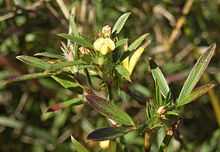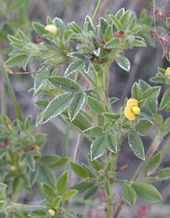Stylosanthes
| Stylosanthes | |
|---|---|
 | |
| Stylosanthes hamata | |
| Scientific classification | |
| Kingdom: | Plantae |
| (unranked): | Angiosperms |
| (unranked): | Eudicots |
| (unranked): | Rosids |
| Order: | Fabales |
| Family: | Fabaceae |
| Subfamily: | Faboideae |
| Tribe: | Dalbergieae[1][2] |
| Genus: | Stylosanthes Sw. |
| Species | |
|
See text. | |
Stylosanthes is a genus of flowering plants in the legume family, Fabaceae and contains numerous highly important pasture and forage species. It was recently assigned to the informal monophyletic Pterocarpus clade of the Dalbergieae.[1][2]
Description
The genus is characterised by trifoliate leaves and small yellow flowers [3] Species may be annual or perennial and morphology varies between species as well as within species in response to grazing pressure. Some species such as S. scabra grow as a low woody shrub to 1.5 m, while others such as S. humilis will grow as a herbaceous shrub but can adopt a prostrate growth form and thrive under high grazing pressure.[4]

Taxonomy and range
Taxonomy of the genus remains unsettled and controversial, with various authors favouring between 25 and 42 species, with at least 40 additional synonyms.[5] The taxonomy is complicated by the existence of numerous natural tetraploid and hybrid populations.[6] Species within the genus fall within two subgenera: Styposanthes and Stylosanthes. Styposanthes possess a small rudimentary secondary floral axis which is absent from Stylosanthes.[7] Stylosanthes is closely related to the peanut genus Arachis.[5]
All except two species of the genus are native to the Americas. S. fruticosa has a native range that extends from South Africa to Ethiopia, across Arabian Peninsula to Pakistan, India and Sri Lanka [8] and S. erecta is endemic to Tropical Africa, from Tanzania to Senegal.[9] The putative species S. sundaica, has a range that encompasses Malesia but is considered by most authors to be an adventive polypoliod variety of S. humilis.[8] Ecological range extends from savanna and thorn scrub to tropical forest and montane forests.[5]
Species
Stylosanthes currently comprises the following species:[10][11][12]
- Stylosanthes acuminata M.B. Ferreira & Sousa Costa[Note 1]
- Stylosanthes angustifolia Vogel
- Stylosanthes aurea M.B. Ferreira & Sousa Costa[Note 1]
- Stylosanthes bahiensis 't Mannetje & G.P. Lewis[Note 2]
- Stylosanthes biflora (L.) Britton et al.
- Stylosanthes bracteata Vogel
- Stylosanthes calcicola Small
- Stylosanthes campestris M.B. Ferreira & Sousa Costa[Note 1]
- Stylosanthes capitata Vogel
- Stylosanthes cayennensis Mohlenbr.[Note 3]
- Stylosanthes debilis M.B. Ferreira & Sousa Costa
- Stylosanthes erecta P. Beauv.
- Stylosanthes figueroae Mohlenbr.[Note 4]
- Stylosanthes fruticosa (Retz.) Alston
- Stylosanthes gracilis Kunth[Note 1]
- Stylosanthes grandifolia M.B. Ferreira & Sousa Costa[Note 1]
- Stylosanthes guianensis (Aubl.) Sw.
- var. dissitiflora (B. L. Rob. & Seaton) ’t Mannetje
- var. guianensis (Aubl.) Sw.
- var. intermedia (Vogel) Hassl.
- var. longiseta (Michaeli) Hassl.
- var. robusta ’t Mannetje
- Stylosanthes guineensis G. Don[Note 5]
- Stylosanthes hamata (L.) Taub.
- Stylosanthes hippocampoides Mohlenbr.[Note 1]
- Stylosanthes hispida Rich.
- Stylosanthes humilis Kunth
- Stylosanthes ingrata S.F. Blake
- Stylosanthes leiocarpa Vogel
- Stylosanthes linearifolia M.B. Ferreira & Sousa Costa
- Stylosanthes macrocarpa S.F. Blake
- Stylosanthes macrocephala M.B. Ferreira & Sousa Costa
- Stylosanthes macrosoma S.F. Blake[Note 6]
- Stylosanthes mexicana Taub.
- Stylosanthes montevidensis Vogel
- Stylosanthes nervosa J.F. Macbr.[Note 7]
- Stylosanthes pilosa M.B. Ferreira & Sousa Costa
- Stylosanthes ruellioides Benth.
- Stylosanthes scabra Vogel
- Stylosanthes seabrana B. L. Maass & ’t Mannetje
- Stylosanthes sericeiceps S.F. Blake
- Stylosanthes suborbiculata Chiov.
- Stylosanthes subsericea S.F. Blake[Note 8]
- Stylosanthes suffruticosa Mohlenbr.[Note 7]
- Stylosanthes sundaica Taub.[Note 4]
- Stylosanthes sympodialis Taub.
- Stylosanthes tomentosa M.B. Ferreira & Sousa Costa
- Stylosanthes tuberculata S.F. Blake[Note 7]
- Stylosanthes viscosa Sw.
Usage
Species within the genus have many properties that make them valuable forage species. They are capable of nitrogen fixation and are capable of improving soil fertility in addition to providing high protein stock feed.[13] The genus is also noted for its ability to extract phosphorus from soils where it is not available to other species.[14] Seeds are hard and long lived leading to high soil seed banks and rapid recovery following fire or heavy grazing. Seed survives passage through the gut of grazing animals and is dispersed widely in this manner allowing for rapid dispersal.[4] Many species are adapted to hot, dry climates and are drought resistant.[15]
These traits have made the genus the world’s most widely used tropical pasture legume.[15] Stylosanthes has been introduced across the tropical world as a pasture species. Its most important use has been in Australia where over a million hectares of primarily native pasture have been oversown with Stylosanthes species; primarily S. hamata, S. scabra and S. humilis [16] This can lead to a ten-fold increase in productivity, though 2–3 fold increases are normal.[4] Stylosanthes are the most important forage legumes in South America [17] and the most important pasture legumes of tropical India.[18] Stylosanthes are also important forage species in tropical Africa.[4]
Stylosanthes are important green manure species in West and Central Africa, primarily S. guianensis and S. hamata, and species are planted and harvested for commercial leaf meal production for poultry and pig feed in China and India. The genus has also been utilized as a nitrogen input into low input or organic cropping systems. Species are utilized as fallow species in Peru, Africa and Australia. S. hamata used for intercropping with grain crops in India and Africa with yield increases up to 25%.[4]
Stylosanthes species have been utilized for land reclamation, soil stabilization and soil regeneration work because of their drought resistance, ability to restore soil fertility, improve soil physical properties and provide permanent vegetation cover.[18][19][20][21]
Despite their ability to dramatically improve productivity in grazing lands, Stylosanthes can also cause problems. Stylosanthes can dominate pasture at the expense of grass which can lead to problems because the plants provides less protection from erosion than grass.[4] Stylosanthes dominance can also lead to soil acidification, as soil nitrate levels build up and are then leached down the soil profile.[22] Stylosanthes species are considered invasive species and environmental weeds in Australia, Taiwan, the pacific Islands and Hawaii.[5] Many Stylosanthes species are susceptible to anthracnose fungus (Colletotrichum gloeosporioides) which retards growth and seed development,[4] and this had led to numerous commercial cultivars being abandoned.
Notes
- 1 2 4 7 8 10 Some sources treat Stylosanthes acuminata, Stylosanthes aurea, Stylosanthes campestris, Stylosanthes gracilis, Stylosanthes grandifolia, and/or Stylosanthes hippocampoides as synonyms of Stylosanthes guianensis.
- 3 Some sources treat Stylosanthes bahiensis as a synonym of Stylosanthes pilosa.
- 5 Some sources treat Stylosanthes cayennensis as a synonym of Stylosanthes hispida.
- 6 15 Some sources treat Stylosanthes figueroae and/or Stylosanthes sundaica as synonyms of Stylosanthes humilis.
- 9 Some sources treat Stylosanthes guineensis as a synonym of Stylosanthes erecta.
- 11 Some sources treat Stylosanthes macrosoma as a synonym of Stylosanthes montevidensis.
- 12 14 16 Some sources treat Stylosanthes nervosa, Stylosanthes suffruticosa, and/or Stylosanthes tuberculata as synonyms of Stylosanthes scabra.
- 13 Some sources treat Stylosanthes subsericea as a synonym of Stylosanthes macrocarpa.
References
- ↑ 1.0 1.1 Lavin M, Pennington RT, Klitgaard BB, Sprent JI, de Lima HC, Gasson PE. (2001). "The dalbergioid legumes (Fabaceae): delimitation of a pantropical monophyletic clade". Am J Bot 88 (3): 503–33. doi:10.2307/2657116. PMID 11250829.
- ↑ 2.0 2.1 Cardoso D, Pennington RT, de Queiroz LP, Boatwright JS, Van Wyk B-E, Wojciechowskie MF, Lavin M. (2013). "Reconstructing the deep-branching relationships of the papilionoid legumes". S Afr J Bot 89: 58–75. doi:10.1016/j.sajb.2013.05.001.
- ↑ Sa R (萨仁), Salinas AD. (2010). "笔花豆属" [61. Stylosanthes Swartz, Prodr. 7, 108. 1788.]. In Wu ZY (吴征镒), Raven PH, Hong DY (洪德元). Flora Republicae Popularis Sinicae [Flora of China]. Vol. 10 (Fabaceae). Missouri Botanical Garden Press, St. Louis, and Science Press, Beijing. pp. 135–136. ISBN 9781930723917. Retrieved 12 February 2014.
- ↑ 4.0 4.1 4.2 4.3 4.4 4.5 4.6 Cameron D, Chakraborty S. (2004). "Forage potential of Stylosanthes in different production systems". In Chakraborty S. High-Yielding Anthracnose-Resistant Stylosanthes for Agricultural Systems. Australian Centre for International Agricultural Research (ACIAR). pp. 27–38. ISBN 1-86320-442-3.
- ↑ 5.0 5.1 5.2 5.3 Maass B, Sawkins, M. (2004). "History, relationships and diversity among Stylosanthes species of commercial significance". In Chakraborty S. High-Yielding Anthracnose-Resistant Stylosanthes for Agricultural Systems. Australian Centre for International Agricultural Research (ACIAR). pp. 9–26. ISBN 1-86320-442-3.
- ↑ Gillies ACM, Abbott RJ. (1996). "Phylogenetic relationships in the genus Stylosanthes (Leguminosae) based upon chloroplast DNA variation". Plant Syst Evol 200 (3–4): 193–211. doi:10.1007/BF00984935.
- ↑ Chandra A. (2009). "Diversity among Stylosanthes species: Habitat, edaphic and agro-climatic affinities leading to cultivar development". J Environ Biol 30 (4): 471–478. PMID 20120482.
- ↑ 8.0 8.1 Cook B, Pengelly B, Brown S, Donnelly J, Eagles D, Franco A, Hanson J, Mullen B, Partridge I, Peters M, Schultze-Kraft R. (2005). "Tropical Forages entry for Stylosanthes". Tropical Forages. CSIRO Sustainable Ecosystems (CSIRO), the Department of Primary Industries and Fisheries (DPI&F Queensland), el Centro Internacional de Agricultura Tropical (CIAT), and the International Livestock Research Institute (ILRI). Retrieved 12 February 2014.
- ↑ USDA, ARS, National Genetic Resources Program. "GRIN species record for Stylosanthes erecta P. Beauv". Germplasm Resources Information Network—(GRIN) [Online Database]. National Germplasm Resources Laboratory, Beltsville, Maryland. Retrieved 12 February 2014.
- ↑ "The Plant List entry for Stylosanthes". The Plant List. Royal Botanic Gardens, Kew and the Missouri Botanical Garden. 2013. Retrieved 11 February 2014.
- ↑ "ILDIS LegumeWeb entry for Stylosanthes". International Legume Database & Information Service. Cardiff School of Computer Science & Informatics. Retrieved 11 February 2014.
- ↑ USDA, ARS, National Genetic Resources Program. "GRIN species records of Stylosanthes". Germplasm Resources Information Network—(GRIN) [Online Database]. National Germplasm Resources Laboratory, Beltsville, Maryland. Retrieved 11 February 2014.
- ↑ Coates DB, Miller CP, Hendricksen RE, Jones RJ. (1997). "Stability and productivity of Stylosanthes pastures in Australia. II. Animal production from Stylosanthes pastures". Trop Grassl 31 (5): 494–502.
- ↑ Kretschmer AE, Pitman WD. (2001). "4. Germplasm Resources of Tropical Forage Legumes". In Sotomayor-Ríos A, Pitman WD. Tropical Forage PLants: Development and Use. CRC Press LLC, Boca Raton, Florida. pp. 41–58. doi:10.1201/9781420038781.ch4. ISBN 0849323185. Retrieved 12 February 2014.
- ↑ 15.0 15.1 Jones PG, Sawkins MC, Maass BL, Kerridge PC. (June 8–19, 1997). GIS and Genetic Diversity—Case Studies in Stylosanthes. XVIII International Grassland Congress. Winnipeg, Canada. pp. 73–74. Retrieved 12 February 2014.
- ↑ Liu CJ. (1997). "Geographical distribution of genetic variation in Stylosanthes scabra revealed by RAPD analysis". Euphytica 9 (1–2): 21–27. doi:10.1023/A:1003026915825.
- ↑ Hall T, Glatzle A. (2004). "Cattle production from Stylosanthes pastures". In Chakraborty S. High-Yielding Anthracnose-Resistant Stylosanthes for Agricultural Systems. Australian Centre for International Agricultural Research (ACIAR). pp. 51–64. ISBN 1-86320-442-3.
- ↑ 18.0 18.1 Chandra A, Pathak PS, Bhatt RK. (2006). "Stylosanthes research in India: Prospects and challenges ahead". Curr Sci 90 (7): 915–921.
- ↑ Pathak P, Ramesh C, Bhatt R. (2004). "Stylosanthes in the reclamation and development of degraded soils in India". In Chakraborty S. High-Yielding Anthracnose-Resistant Stylosanthes for Agricultural Systems. Australian Centre for International Agricultural Research (ACIAR). pp. 85–96. ISBN 1-86320-442-3.
- ↑ Obi ME. (1999). "The physical and chemical responses of a degraded sandy clay loam soil to cover crops in southern Nigeria". Plant and Soil 211 (2): 165–172. doi:10.1023/A:1004609104524.
- ↑ Ramesh CR, Bhag Mal, Hazra CR, Sukanya DH, Ramamurthy V, Chakraborty S. (1997). "Status of Stylosanthes development in other countries. III. Stylosanthes development and utilisation in India". Trop Grassl 31 (5): 467–476.
- ↑ Noble AD, Cannon M, Muller D. (1997). "Evidence of accelerated soil acidification under Stylosanthes-dominated pastures". Aust J Soil Res 35 (6): 1309–1322. doi:10.1071/S97053.